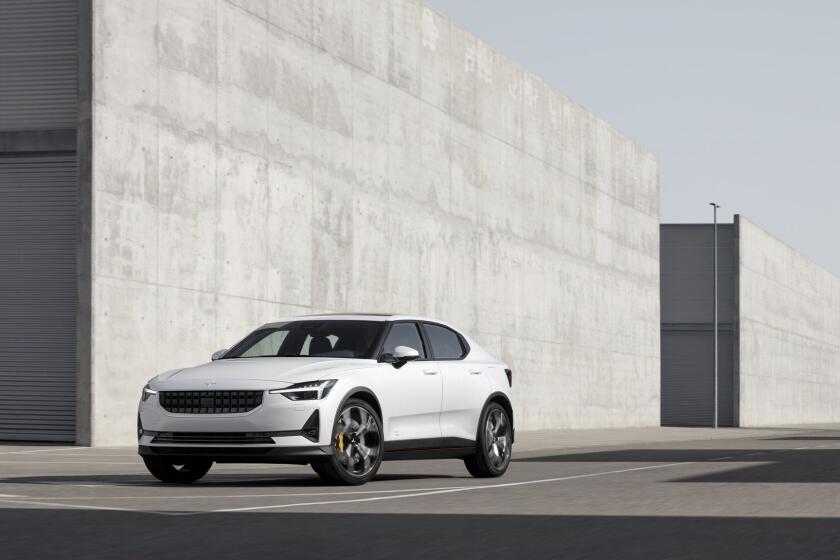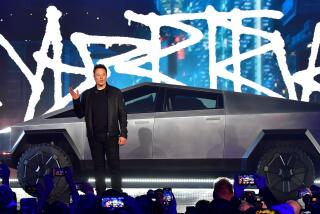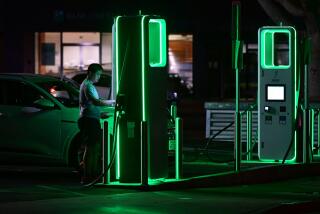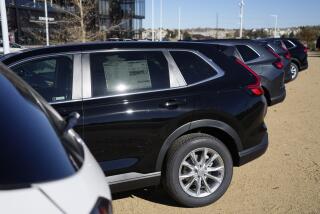Not sure you’re ready for an EV? Try one out with a microlease
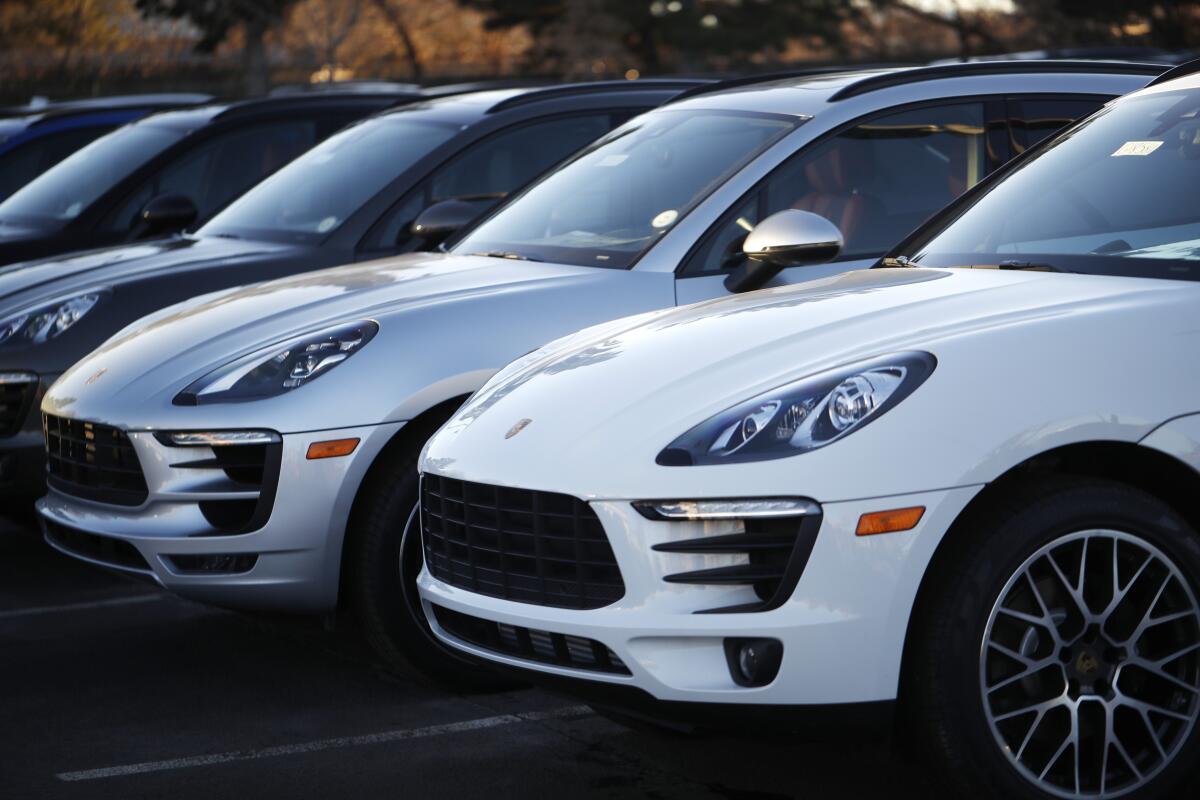
- Share via
The Polestar 3 is the type of electric vehicle that drivers go mad for these days. It’s safe, a little swanky and, crucially, a Goldilocks SUV — not too big and not too small. There’s just one problem: Polestar won’t start delivering it en masse for a couple of months.
That’s not stopping the carmaker from getting butts in drivers’ seats now. In October, Polestar started offering what it calls a “flexible lease.” Customers can drive off in the only car the company currently makes — its “2” sedan — and then scrap the lease in as little as five months. If all goes as Polestar has planned, those drivers will hand in the keys to a 2 and go home in a 3.
“Let’s put it this way: It’s an extended test drive,” said Gregor Hembrough, chief executive of Polestar USA. “With a lot of customers, their leases are expiring and every one of our rivals have something for them to go into, so we had to step up to the plate.”
Polestar isn’t alone: Subscriptions, short-term leases and other tactics for microdosing the ordeal of getting a new vehicle are having a moment. The transition to electric cars is turbocharging such arrangements, which entice both the EV-curious and those would-be buyers awaiting a specific electric model. Automakers and dealers are also tapping into a swath of customers increasingly comfortable renting a wide variety of things, including clothes and TV shows.
Although short-term setups may not be cheaper than car ownership in the long run, they are helping drivers dodge hefty upfront payments while EV prices and interest rates are still relatively high. There are also more EVs to hold out for than ever. Although the U.S. market now boasts 55 distinct electric models, that number is expected to grow 20% to 30% next year. New cars in the pipeline include the next iteration of the Hyundai Ioniq and the long-awaited Volkswagen ID.Buzz, as well as a parade of three-row SUVs.
Carmakers and dealers, meanwhile, can use microleases to more easily monetize a growing glut of EV inventory. Philipp Sadek, a principal at Boston Consulting Group, predicts subscriptions and short-term leases could soon account for as much as 15% of new car transactions around the world, compared with “low single digits” now. “The car buying process today is still very tedious,” Sadek said. “With this, one moves from ownership to usership.”
In some ways, the short-term car lease is the renaissance of a bad business idea. From 2017 through 2019, many carmakers rolled out subscription products — essentially month-to-month microleases — only to scrap them in short order. Audi, BMW, Cadillac, Ford and Mercedes-Benz all gave their sedans and SUVs the Spotify treatment before reversing course.
Tesla Inc. has just started building a factory in China with plans to start churning out Model 3s by the end of the year.
The misstep, Sadek said, was that automakers built their programs on a buffet model that let consumers sample a different car every month. Not only did that require a lot of expensive, idle inventory, but also most drivers preferred to get comfortable in one ride.
“It’s expensive to run and hard to do profitably,” said Elaine Buckberg, a Harvard economist who worked at General Motors during the subscription boom. “So if you’re a carmaker, you may need to have another objective.”
Half a decade after that wave of proto-subscriptions, most auto executives and their dealer networks still prefer to do business the old-fashioned way. But some of them, as well as rental companies and startups such as Polestar, are circling back to short-term leases in a bid to lure ever more capricious consumers and bridge the gap until more EV options emerge.
Finn, a Germany-based car-subscription service, has raised roughly $1 billion over the last four years and now operates in 11 U.S. states. Its transactions are managed entirely online and Finn will even drop off cars in subscribers’ driveways. Sixt, a German car-rental empire, started selling subscriptions in 2020 and today offers them in 10 countries. The company declined to share how many subscribers it has, but said the number doubled this year. “The growth rate confirms that we are hitting the pulse of the times with this offer,” a Sixt spokesman said via email.
AutoNation Inc., which runs about 250 dealerships in the U.S., recently started offering its own microleases in six- and 12-month increments. Ivan Mihov, vice president of mobility, said it’s the company’s response to car subscriptions. “The three-year lease doesn’t work for everybody,” he said. “With EVs in particular, obviously there are a lot of people on the fence.”
Ryan Johnson, a software developer in Boston, has been driving subscription Volvos since 2020; he’s now on his fourth. The arrangement let Johnson go electric years earlier than he had planned: He slid into his first hybrid XC60 in 2021.
“I’ve had 16 cars over 34 years, so this fits the way I like to drive cars,” Johnson said. “If I can, I’m never buying another one.”
In the U.S., Volvo and Porsche are the only major carmakers to have stuck with subscriptions for the long term. Through Volvo’s 7-year-old Care program, Johnson pays about $1,300 a month for his XC60, which retails for $74,000. He considers it a good deal, in part because that price includes insurance, maintenance and other fees.
Today’s microlease enthusiasts are a mixed bag — from young drivers unsure of what their lives will look like in a few months, to older affluent couples. Florida snowbirds, for example, sign up for a car for the season. Urban millennials are booking convertibles solely for the summer.
“We’re separating access from ownership,” said Mihov at AutoNation. “And there’s a whole spectrum of different use cases.”
Since Polestar launched its flexible lease program in October, roughly half of the carmaker’s customers have opted for the product instead of a longer-term lease or buying outright. Hembrough at Polestar said EV buyers are “less brand-loyal,” which can be both a challenge and a blessing for an upstart carmaker. “For the most part, 100% of my customers” are conquests, he said, meaning they have to be lured away from another brand.
Hembrough also is looking forward to taking back an assortment of slightly used Polestar 2 sedans, which can be deployed to court less-affluent customers in the market for a cheaper EV.
Andy Axelrod, who heads Volvo’s Care initiative, expects participation to increase as the carmaker prepares to launch the long-expected EX30 and EX90 SUVs. But he said a core group of subscribers has been with the program since it started.
“Over time, I’ve seen names continue to pop up and you begin to recognize them,” Axelrod said. “It’s not a means to an end for them; it’s their preferred way of owning and driving a vehicle.”
More to Read
Inside the business of entertainment
The Wide Shot brings you news, analysis and insights on everything from streaming wars to production — and what it all means for the future.
You may occasionally receive promotional content from the Los Angeles Times.
